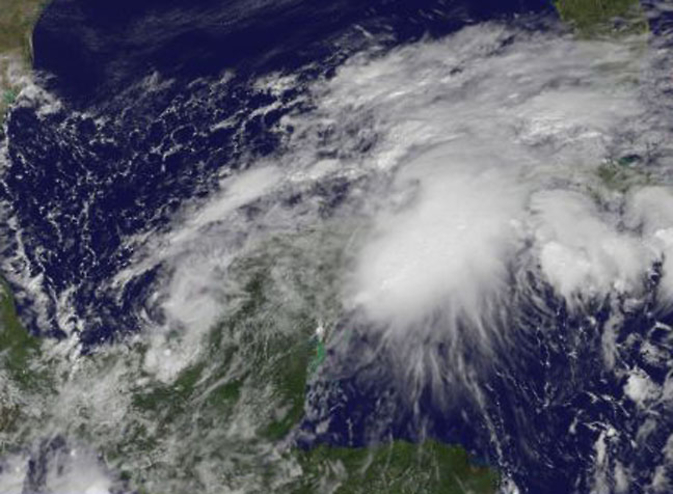Tropical Depression 9 Forms in Gulf of Mexico

NOAA's GOES-East Satellite captured the birth of Tropical Depression 9 on Oct. 22 at 1600 UTC (12 p.m. EDT) in the western Bay of Campeche. Image Credit: NASA/NOAA GOES Project
NOAA's GOES-East Satellite captured an image of the birth of Tropical Depression 9 on Oct. 22 at 1600 UTC (12 p.m. EDT) in the western Bay of Campeche. The clouds associated with the depression stretched over the Yucatan Peninsula and into the western Caribbean Sea.
On Oct. 22, a Tropical Storm Warning was in effect from Celestun to Frontera, Mexico. The National Hurricane Center noted that the center of tropical depression nine (TD9) was located near latitude 19.4 north and longitude 92.4 west.
The depression is stationary, but a slow eastward motion should begin later today. On the forecast track…the center of the Tropical cyclone will be near the coast of the Mexican State of Campeche tonight or early Thursday.
Maximum sustained winds remain near 35 mph (55 kph) and the depression could become a tropical storm before it moves inland.
The depression is expected to produce total rainfall accumulations of 5 to 10 inches across the Yucatan Peninsula of Mexico with a maximum of 15 inches possible.
These rainfall amounts may produce life-threatening flash floods. Tropical storm conditions are expected to begin in portions of the warning area by late this afternoon or evening.
Tropical Depression 9 is expected in intensify to tropical storm strength before making landfall in the Yucatan Peninsula.
Rob Gutro
NASA's Goddard Space Flight Center
Media Contact
More Information:
http://www.nasa.gov/content/goddard/td9-atlantic-ocean/All latest news from the category: Earth Sciences
Earth Sciences (also referred to as Geosciences), which deals with basic issues surrounding our planet, plays a vital role in the area of energy and raw materials supply.
Earth Sciences comprises subjects such as geology, geography, geological informatics, paleontology, mineralogy, petrography, crystallography, geophysics, geodesy, glaciology, cartography, photogrammetry, meteorology and seismology, early-warning systems, earthquake research and polar research.
Newest articles

Properties of new materials for microchips
… can now be measured well. Reseachers of Delft University of Technology demonstrated measuring performance properties of ultrathin silicon membranes. Making ever smaller and more powerful chips requires new ultrathin…

Floating solar’s potential
… to support sustainable development by addressing climate, water, and energy goals holistically. A new study published this week in Nature Energy raises the potential for floating solar photovoltaics (FPV)…

Skyrmions move at record speeds
… a step towards the computing of the future. An international research team led by scientists from the CNRS1 has discovered that the magnetic nanobubbles2 known as skyrmions can be…




















